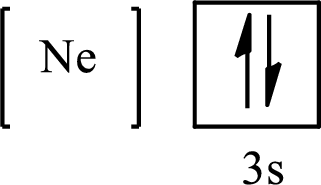
Interpretation:
The ions from
Concept introduction:
Paramagnetism is a form of magnetism where the materials are weakly attracted by an externally applied magnetic field. It is due to the presence of unpaired electrons in the materials so all the atoms with incompletely filled atomic orbital are paramagnetic.
The intensity of paramagnetism increases with the increase in the number of unpaired electrons. Due to their spin, the unpaired electrons have a magnetic dipole moment and act like tiny magnets.
Answer to Problem 8.97P
Explanation of Solution
The paramagnetic nature of the ions of iron can be determined by the presence of unpaired electrons. The
The condensed electronic configuration of
Its partial orbital diagram is as follows:

The condensed electronic configuration of
Its partial orbital diagram is as follows:

The condensed electronic configuration of
Its partial orbital diagram is as follows:

The condensed electronic configuration of
Its partial orbital diagram is as follows:

The condensed electronic configuration of
Its partial orbital diagram is as follows:

The condensed electronic configuration of
Its partial orbital diagram is as follows:

The condensed electronic configuration of
Its partial orbital diagram is as follows:

The condensed electronic configuration of
Its partial orbital diagram is as follows:

The condensed electronic configuration of
Its partial orbital diagram is as follows:

The condensed electronic configuration of
Its partial orbital diagram is as follows:

The condensed electronic configuration of
Its partial orbital diagram is as follows:

The condensed electronic configuration of
Its partial orbital diagram is as follows:

The condensed electronic configuration of
Its partial orbital diagram is as follows:

The condensed electronic configuration of
Its partial orbital diagram is as follows:

Want to see more full solutions like this?
Chapter 8 Solutions
Chemistry: The Molecular Nature of Matter and Change
- Which does NOT describe a mole? A. a unit used to count particles directly, B. Avogadro’s number of molecules of a compound, C. the number of atoms in exactly 12 g of pure C-12, D. the SI unit for the amount of a substancearrow_forward5 What would the complete ionic reaction be if aqueous solutions of potassium sulfate and barium acetate were mixed? ed of Select one: O a 2 K SO4 + Ba2 +2 C₂H3O21 K+SO4 + Ba2+ + 2 C2H3O21 K+SO42 + Ba2 +2 C2H3O2 BaSO4 +2 K+ + 2 C2H3O estion Ob. O c. Od. 2 K SO4 +Ba2 +2 C₂H₂O₂ BaSO4 + K+ + 2 C2H3O BaSO4 + K + 2 C2H301 →Ba² +SO42 +2 KC2H3O s pagearrow_forward(28 pts.) 7. Propose a synthesis for each of the following transformations. You must include the reagents and product(s) for each step to receive full credit. The number of steps is provided. (OC 4) 4 steps 4 steps OH b.arrow_forward
- LTS Solid: AT=Te-Ti Trial 1 Trial 2 Trial 3 Average ΔΗ Mass water, g 24.096 23.976 23.975 Moles of solid, mol 0.01763 001767 0101781 Temp. change, °C 2.9°C 11700 2.0°C Heat of reaction, J -292.37J -170.473 -193.26J AH, kJ/mole 16.58K 9.647 kJ 10.85 kr 16.58K59.64701 KJ mol 12.35k Minimum AS, J/mol K 41.582 mol-k Remember: q = mCsAT (m = mass of water, Cs=4.184J/g°C) & qsin =-qrxn & Show your calculations for: AH in J and then in kJ/mole for Trial 1: qa (24.0969)(4.1845/g) (-2.9°C)=-292.37J qsin = qrxn = 292.35 292.37J AH in J = 292.375 0.2923kJ 0.01763m01 =1.65×107 AH in kJ/mol = = 16.58K 0.01763mol mol qrx Minimum AS in J/mol K (Hint: use the average initial temperature of the three trials, con Kelvin.) AS=AHIT (1.65×10(9.64×103) + (1.0 Jimaiarrow_forwardFor the compound: C8H17NO2 Use the following information to come up with a plausible structure: 8 This compound has "carboxylic acid amide" and ether functional groups. The peaks at 1.2ppm are two signals that are overlapping one another. One of the two signals is a doublet that represents 6 hydrogens; the other signal is a quartet that represents 3 hydrogens.arrow_forwardVnk the elements or compounds in the table below in decreasing order of their boiling points. That is, choose 1 next to the substance with the highest bolling point, choose 2 next to the substance with the next highest boiling point, and so on. substance C D chemical symbol, chemical formula or Lewis structure. CH,-N-CH, CH, H H 10: H C-C-H H H H Cale H 10: H-C-C-N-CH, Bri CH, boiling point (C) Сен (C) B (Choosearrow_forward
 ChemistryChemistryISBN:9781305957404Author:Steven S. Zumdahl, Susan A. Zumdahl, Donald J. DeCostePublisher:Cengage Learning
ChemistryChemistryISBN:9781305957404Author:Steven S. Zumdahl, Susan A. Zumdahl, Donald J. DeCostePublisher:Cengage Learning ChemistryChemistryISBN:9781259911156Author:Raymond Chang Dr., Jason Overby ProfessorPublisher:McGraw-Hill Education
ChemistryChemistryISBN:9781259911156Author:Raymond Chang Dr., Jason Overby ProfessorPublisher:McGraw-Hill Education Principles of Instrumental AnalysisChemistryISBN:9781305577213Author:Douglas A. Skoog, F. James Holler, Stanley R. CrouchPublisher:Cengage Learning
Principles of Instrumental AnalysisChemistryISBN:9781305577213Author:Douglas A. Skoog, F. James Holler, Stanley R. CrouchPublisher:Cengage Learning Organic ChemistryChemistryISBN:9780078021558Author:Janice Gorzynski Smith Dr.Publisher:McGraw-Hill Education
Organic ChemistryChemistryISBN:9780078021558Author:Janice Gorzynski Smith Dr.Publisher:McGraw-Hill Education Chemistry: Principles and ReactionsChemistryISBN:9781305079373Author:William L. Masterton, Cecile N. HurleyPublisher:Cengage Learning
Chemistry: Principles and ReactionsChemistryISBN:9781305079373Author:William L. Masterton, Cecile N. HurleyPublisher:Cengage Learning Elementary Principles of Chemical Processes, Bind...ChemistryISBN:9781118431221Author:Richard M. Felder, Ronald W. Rousseau, Lisa G. BullardPublisher:WILEY
Elementary Principles of Chemical Processes, Bind...ChemistryISBN:9781118431221Author:Richard M. Felder, Ronald W. Rousseau, Lisa G. BullardPublisher:WILEY





